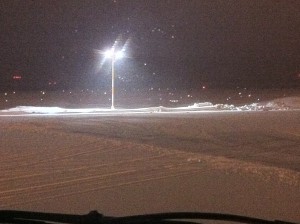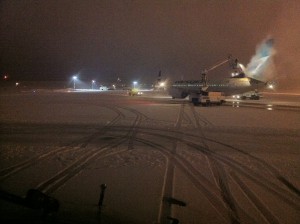ATIS is calling visibility 3 statute miles, light snow, ceiling broken at 1,500, overcast at 3,000, and winds from the south at 8 knots. But first…
We began the day by arriving to the plane at 0545 local. It was snowing and our bird was wrapped in a blanket of fluffy, white, precipitation goodness. Captain says, “I’ve got the walk around this morning.” How nice of him.
I prepared the flight deck for departure as I normally do, running the first flight of the day system checks and find everything to be in working order. Captain arrives from his preflight inspection to report “this much snow” inside the engine inlets. He motions with his hands to demonstrate the presence of roughly 4 inches of snow.

It’s now time for push back, however, I can’t start the jet engines until the snow is cleared from the inlets. The ground personnel seem somewhat confused with my request. “Could you guys get a ladder and scoop the snow out of our engine?”, I ask. “Uh, sure. No problem.”
We push back from gate and start the engines, first the right engine, and the left. The ramp is slick and covered in snow so we delay our taxi checklist and leave the flaps retracted to avoid contamination buildup. The Embraer 145 flaps are located aft of the main landing gear. Taxiing on contaminated surfaces with flaps extended slings snow and ice off the tires to the underside of flaps. It looks like you ran over Frosty the snowman.
Company procedure states delaying flap extension as long as practical during ground operations for this exact reason. Besides, we needs flaps up for our deicing configuration anyway.
We arrive at deice pad 1 where the marshaller leads us into place. I run the deice configuration checklist; “both engines are running, APU (auxiliary power unit) is off, brakes are set, you may begin deicing.” I declare.
Deicing trucks descend upon us like a scene from ‘The Matrix,’ vehicles swarming all over, lights flashing, and red fluid dripping down my windscreen. 10 minutes later I’m told we are free of all contaminants and may exit the deice pad.

I check the deice fluid holdover charts and determine we have between 35 minutes and 75 minutes of precipitation protection before we would have to be sprayed down again. Holdover charts tell us how long the specific brand of deice fluid will protect the flight control surfaces. Certain variables such as outside air temperature, type and intensity of precipitation dictate how long the fluid will last before a safe takeoff is no longer permissible. With 0 degrees Celsius and light snow, we have plenty of time to make a safe takeoff. Perfect.
We proceed to taxi to Runway 23 for departure. Instructions are taxi via Golf, Foxtrot, and hold short of Runway 14. I overhear the tower clearing an Air Canada Jazz CRJ for landing. Winds are now from the south at 10 knots, gusting 20 knots. Delightful, considering the runway is 70 percent trace snow and only 30 percent bare and I’ve got a pretty good crosswind component. I brief, “If we have to abort the takeoff, it’ll be max reverse thrust and easy on the brakes so we don’t skid off the runway.” Now I’m really excited as we taxi onto Runway 23.
“Contact departure airborne, you’re cleared for takeoff Runway 23.”, the booming tower controller states. “Set thrust.” “Thrust set.” “80 knots.” “Crosscheck.” “V1, rotate. Positive rate.” “Gear up,” and away we go.
